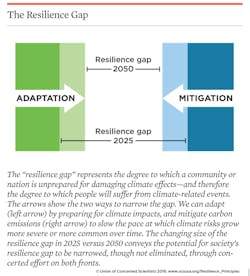Since beginning Clark’s Remarks in 2013, I have frequently addressed various aspects of climate change and sea level rise. As a sustainability professional, most of my focus has been on mitigation by reducing greenhouse gas (GHG) emissions through the implementation of energy efficiency measures and by promoting renewable energy. Except for landscaping strategies, such as increasing tree canopies, I have pretty much left the adaptation issues to the architects and design engineers.
However, with another season of record-breaking severe weather events, I believe that it’s time for sustainability professionals to pay more attention to resiliency. I’m not saying that continuing our efforts to curb GHG emissions should be neglected, but we need to take more action to reduce the vulnerability of our homes and businesses to the consequences of climate change.
In 2007, Dr. Rosina Bierbaum said that the question was no longer whether the climate was changing, but rather, “can society manage the unavoidable changes and avoid the unmanageable?” ("Confronting Climate Change: Avoiding the Unmanageable, Managing the Unavoidable"). That, in its essence, is the purpose of adaptation. More recently, the Union of Concerned Scientists issued a report entitled “Toward Climate Resilience: A Framework and Principles for Science-Based Adaptation” that put forward 15 principles that decision-makers can use to prioritize their climate change adaptation strategies.
The report introduces the concept of a climate resilience gap: the scope and extent of climate change-driven conditions for which the population remains unprepared and, therefore, vulnerable to harm.
In other words, in order to reduce the resilience gap, we must address both mitigation and adaptation solutions.
Here is a list – and my summary – of the 15 principles outlined in the report, in which the audience decision-makers are asked to use rigorous science:
- Consider projected climate conditions – don’t neglect history!
- Use systems thinking – our world is interconnected;
- Match the scope of planning to the magnitude of projected change – the urgency of our situation here in South Florida is greater than in many other locales;
- Aim for robust decisions and policies – ensure that policies are appropriate for a wide range of conditions;
- Create opportunities to revise and change course – priorities change, and so should your plans;
- Ensure that the costs of responding to climate change and the benefits of resilience-building are equitably shared – costs and benefits must be fairly shared;
- Decide with, not for – remember that the local residents are the primary stakeholders!
- Minimize harm and maximize options – budgets will always be tight, and tradeoffs must be made carefully;
- Equip and empower local experts – those stakeholders addressed in #7 above need to be trained to work with the experts;
- Maximize transparency, accountability, and follow through – it won’t work without trust;
- Weed out maladaptation, both existing and proposed – watch out for policies that could make communities less prepared for climate change;
- Consider the costs of inaction - one dollar spent on preparedness can save four dollars in recovery!
- Work to protect what people cherish – don’t neglect those things, animate and inanimate, important to our heritage;
- Reflect a long-term vision – take the long view, it’s for our future;
- Appreciate limits to adaptation and push mitigation – adaptation is now, mitigation is the permanent solution.
There’s an old saying that if you’re not part of the solution, then you’re part of the problem. That, it seems to me, is no truer than when dealing with climate change.
A regular contributor to HPAC Engineering and a member of its editorial advisory board, the author is a principal at Sustainable Performance Solutions LLC, a south Florida-based engineering firm focusing on energy and sustainability.









